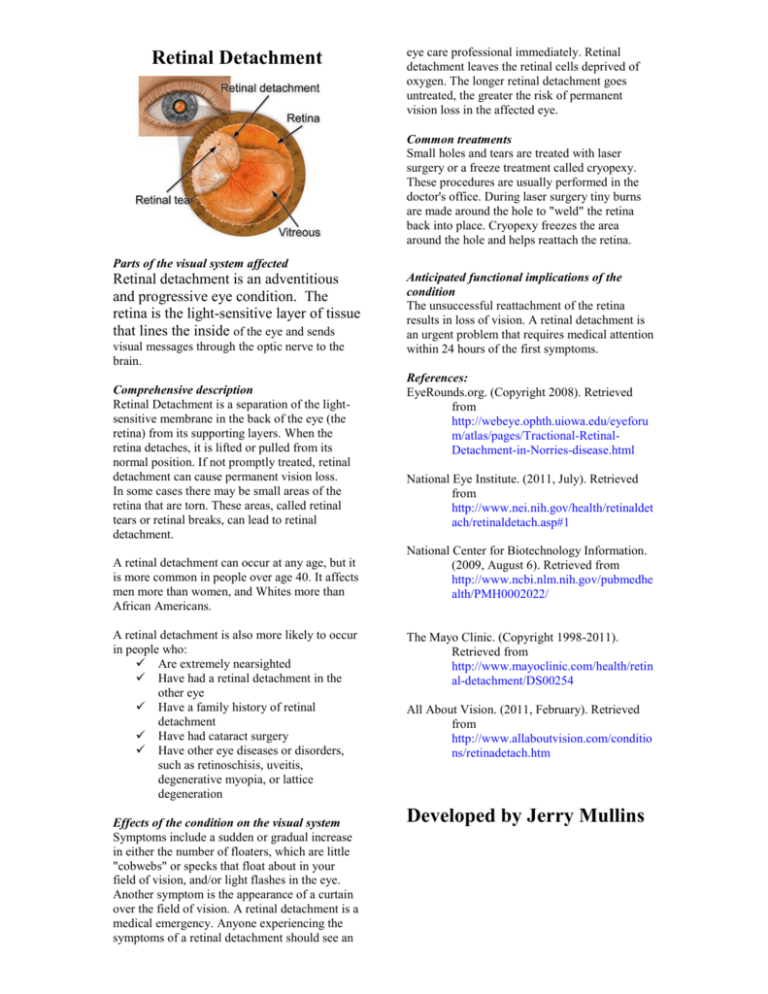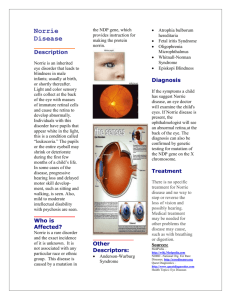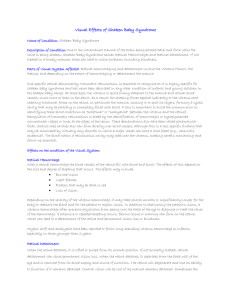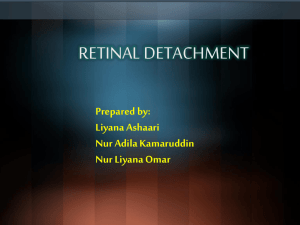Mullins
advertisement

Retinal Detachment eye care professional immediately. Retinal detachment leaves the retinal cells deprived of oxygen. The longer retinal detachment goes untreated, the greater the risk of permanent vision loss in the affected eye. Common treatments Small holes and tears are treated with laser surgery or a freeze treatment called cryopexy. These procedures are usually performed in the doctor's office. During laser surgery tiny burns are made around the hole to "weld" the retina back into place. Cryopexy freezes the area around the hole and helps reattach the retina. Parts of the visual system affected Retinal detachment is an adventitious and progressive eye condition. The retina is the light-sensitive layer of tissue that lines the inside of the eye and sends visual messages through the optic nerve to the brain. Comprehensive description Retinal Detachment is a separation of the lightsensitive membrane in the back of the eye (the retina) from its supporting layers. When the retina detaches, it is lifted or pulled from its normal position. If not promptly treated, retinal detachment can cause permanent vision loss. In some cases there may be small areas of the retina that are torn. These areas, called retinal tears or retinal breaks, can lead to retinal detachment. A retinal detachment can occur at any age, but it is more common in people over age 40. It affects men more than women, and Whites more than African Americans. A retinal detachment is also more likely to occur in people who: Are extremely nearsighted Have had a retinal detachment in the other eye Have a family history of retinal detachment Have had cataract surgery Have other eye diseases or disorders, such as retinoschisis, uveitis, degenerative myopia, or lattice degeneration Effects of the condition on the visual system Symptoms include a sudden or gradual increase in either the number of floaters, which are little "cobwebs" or specks that float about in your field of vision, and/or light flashes in the eye. Another symptom is the appearance of a curtain over the field of vision. A retinal detachment is a medical emergency. Anyone experiencing the symptoms of a retinal detachment should see an Anticipated functional implications of the condition The unsuccessful reattachment of the retina results in loss of vision. A retinal detachment is an urgent problem that requires medical attention within 24 hours of the first symptoms. References: EyeRounds.org. (Copyright 2008). Retrieved from http://webeye.ophth.uiowa.edu/eyeforu m/atlas/pages/Tractional-RetinalDetachment-in-Norries-disease.html National Eye Institute. (2011, July). Retrieved from http://www.nei.nih.gov/health/retinaldet ach/retinaldetach.asp#1 National Center for Biotechnology Information. (2009, August 6). Retrieved from http://www.ncbi.nlm.nih.gov/pubmedhe alth/PMH0002022/ The Mayo Clinic. (Copyright 1998-2011). Retrieved from http://www.mayoclinic.com/health/retin al-detachment/DS00254 All About Vision. (2011, February). Retrieved from http://www.allaboutvision.com/conditio ns/retinadetach.htm Developed by Jerry Mullins









